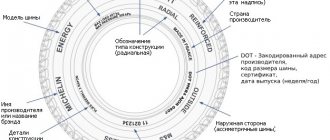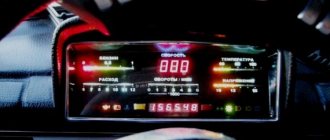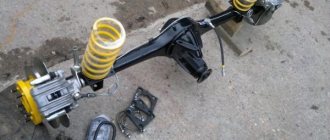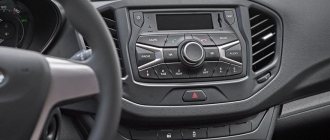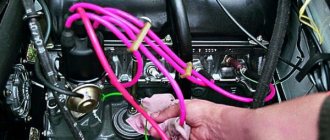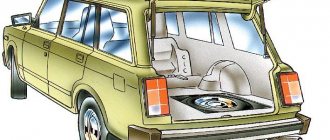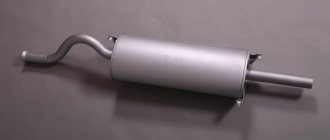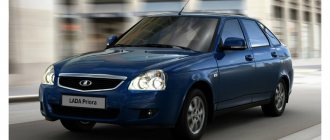Aerodynamic drag of the car
During the design and creation process, designers carefully consider the aerodynamics of the car, since it has a significant impact on the technical performance of the model.
When a car moves, most of the power of the power plant is spent on overcoming the resistance created by the air. And properly created aerodynamics of the car allows you to reduce this resistance, which means that you will need to spend less power and, accordingly, less fuel to combat the resistance of the oncoming air flow.
Vehicle aerodynamics measurements are used to study the forces created by air flow on the vehicle. And there are several such forces - lifting and lateral, as well as drag.
Project of a passenger car, with a carrying capacity of 4 people, micro hatchback
We accept the transmission efficiency:
= 0,92
1.1.7 The streamlining factor of the car
kF
and the designed car are chosen based on literature data. You can select it approximately according to the table:
We accept the streamlining factor kF = 0.55
1.2 Vehicle traction calculation
1.2.1 Determination of the effective engine power and construction of the external speed characteristics of the engine
To determine the required effective engine power, the power balance equation is used. Since the maximum speed of the vehicle and its load capacity are specified in the initial data for the course work, the implementation of these initial parameters of the designed vehicle determines the effective engine power when realizing its maximum speed at the rated load capacity. This power can be determined by the formula:
Drag and coefficient Cx
For the most part, all work on a car body is aimed at overcoming drag, since this force is the most significant.
Air flow movement
The calculations are based on the force of air resistance. To calculate the result, data such as air density, the transverse projection area of the car, and the aerodynamic drag coefficient (Cx) are used - this is the most important indicator in the aerodynamics of the car. At the same time, the resistance force is also significantly influenced by the speed of movement. So, doubling the speed will be accompanied by a 4-fold increase in resistance. Speed is one of the most powerful factors in increasing consumption.
For example, for a well-streamlined car with a projection area of 2 m2 and a coefficient of 0.3 when driving at a speed of 60 km/h, 2.4 hp are needed to overcome air resistance, and at a speed of 120 km/h already 19.1 liters .With. The difference in fuel consumption under such conditions reaches 30% per 100 km.
If you currently require maximum fuel economy, you need to maintain a constant speed of about 60 km/h. In this driving mode, consumption will be minimal even for a car with a large Cx.
Let's look at everything in a simple way. Air has its own density, and a considerable one. When moving, the car has to pass through the existing air masses, which creates a flow that flows around the body. And the easier it is for a car to “cut” the air mass, the less energy it will spend on it.
But it's not that simple. While driving, an area of increased pressure is created in front of the car (the car compresses the air mass), that is, an invisible barrier is formed in front, complicating the “cutting” of the air mass.
Also, after flowing around the body, the air flow separates from the surface, which causes turbulence and vacuum behind the car. In combination with increased pressure, the resulting vacuum further increases resistance.
Since it is impossible to influence air density, designers can only make adjustments to two other calculated components - the area of the car and the aerodynamic drag coefficient.
But it doesn’t seem particularly possible to reduce the projection of a car without compromising the useful spaces of the body (it’s simply impossible to make a car smaller than it is), so all that remains is to change the Cx coefficient.
This coefficient is established experimentally (in a wind tunnel) and characterizes the ratio of drag to velocity pressure and cross-sectional area of the body. Its size is dimensionless.
A drop-shaped body has the lowest aerodynamic drag coefficient. When moving in an air mass, such a body smoothly spreads the flow in front of itself, without creating an area of high pressure, and the existing “tail” allows the flow to close behind itself without breaks or turbulence, that is, there is also no vacuum. It turns out that the air simply flows around the body, creating minimal resistance. For such a body, the coefficient Cx is only 0.05.
Designers, working with the aerodynamics of the car, have not yet been able to achieve such indicators. And all because when moving, resistance is created by several factors:
- Body shape;
- Friction of the flow on the surface during flow;
- Flow entering the engine compartment and interior.
Therefore, for modern cars, the aerodynamic drag coefficient is considered excellent if its value is below 0.3. For example, the Peugeot 308 has a coefficient of 0.29, the Audi A2 has a coefficient of 0.25, and the Toyota Prius has a coefficient of 0.26. But it is worth noting that these are estimates under ideal conditions. In practice, while driving, a car is affected by many different factors that negatively affect the resistance of the body.
It is noteworthy that the coefficient is most influenced not by the front of the car, but by its rear. And the reason for this is the creation of vacuum and turbulence as a result of flow separation from the body. Therefore, designers for the most part are engaged in giving the necessary shape to the rear part.
The drag coefficient of the Volkswagen XL1 is only 0.19
The Cx coefficient can also be reduced by reducing the number of protruding parts, everywhere on the car (sides, roof, bottom, front), and those elements that cannot be removed from the surface are given the maximum possible streamlined shape.
Saab 92
When Saab designed the first car, they benefited from their experience in aircraft manufacturing, where aerodynamics play an important role from the very beginning. In 1949, the company released the Saab 92, with an excellent drag coefficient of 0.30.
See also: This is how much more fuel is wasted due to the load on the roof of the car
This car easily covered speeds of 100 km/h, despite the low power of the two-stroke 25-horsepower engine.
Lift and downforce
As a result of uneven air flow around the car from different sides, a difference in the speed of its movement occurs.
Effective lift and downforce
The car moves and cuts through the air flow, while part of this flow goes under the car and passes under the bottom, that is, it moves almost in a straight line. But the upper part of the flow has to follow the shape of the body, and it has to travel a greater distance. Because of this, a difference in air speed occurs - the upper part moves faster than the lower part, passing under the car. And since an increase in speed is accompanied by a decrease in pressure, a zone of increased pressure is formed under the bottom, which lifts the car.
Frontal resistance also adds problems. The area of high pressure of the air mass in front of the car presses the front end to the road, while the vacuum and turbulence behind, on the contrary, contribute to raising the body. Lift, like drag, increases with increasing speed.
But this force can also have a positive effect. By making adjustments to the design of the car, it is possible to convert the lift force into downforce, which will provide better traction, stability of the car, and its handling at high speeds.
At the same time, no separate solutions are required to obtain downforce. All developments aimed at reducing the Cx coefficient also affect the clamping force. For example, optimizing the shape of the rear end leads to a reduction in turbulence and vacuum, which also reduces lift and increases downforce. Installing the rear spoiler works in the same way.
Front engine, front wheel drive
In such cars, all the power is concentrated in the front. To eliminate the negative effect of air masses, it is necessary to acquire a front splitter, which is often called a “bumper lip”.
Another useful part for creating downforce is a deflector on the bumper (also installed on the front of the car).
These two do enough to give the car extra downforce and reduce power loss.
What else affects aerodynamics?
Of course, designers are trying to reduce the car's drag as much as possible when driving and increase downforce. But the peculiarities of car operation and car owners’ views on the external features of the car make their own adjustments, and in some cases, significant ones.
Aerodynamic drag of different cars depending on speed
For example, installing a roof rack, even with an aerodynamic shape, increases the transverse projection of the car and greatly affects the streamlining, which immediately affects fuel consumption.
Also, consumption increases from driving with the windows and sunroof open, the use of protective and decorative body kits, transportation of oversized cargo protruding from the car, violation of the position of structural elements located under the bottom, and increased ground clearance.
But the car owner can also make adjustments that will positively affect the aerodynamics of the car. These include the use of aerodynamic body kits, installation of a spoiler, and reduction of ground clearance.
The kings of aerodynamics in the automotive world.
Aerodynamics is a mystery of the universe, which, of course, has long been solved by scientists, designers and engineers of the automotive industry. From the very beginning of the appearance of cars in our world, aerodynamics has gone hand in hand with them. Yes, there was a time when automakers forgot about the importance of aerodynamics. Especially when fuel was cheaper than alcohol. But today, when gasoline and diesel fuel do not please with their price tags at gas stations in many countries, the physics of a solid body moving in the air is fundamental to the acceleration and efficiency of cars.
Recall that the coefficient of air drag affects how a car consumes fuel at speed. The same applies to electric cars, for which aerodynamics plays a paramount role, since the lower the air resistance, the less electricity is consumed to power the electric motor.
Thanks to the development of aerodynamics in the auto industry, many cars have become more streamlined than their predecessors. But in the history of the automotive world there have been many examples when car companies tried to experiment with unusual aerodynamic shapes. Unfortunately, in most cases, consumers did not appreciate the result because the form did not correspond to the spirit of the times.
We have collected for you the most interesting and unusual cars with strange aerodynamic bodies. Some projects are unsuccessful, some are quite surprising even today.
Windage
Fuel consumption, especially at high speeds, is significantly influenced by air resistance (aerodynamic drag) , the aerodynamic drag force is proportional to the square of the speed and is calculated by the formula
where S is the frontal projection area of the car, m2; v – vehicle speed relative to air, m/s; ρ – air density, kg/m3; cх – aerodynamic drag coefficient.
Aerodynamic drag does not depend on the mass of the vehicle [2]. The frontal projection area of the car is determined by the shape of the body and the requirements to ensure a comfortable position for the driver and passengers in the seats. For example, a large car may be lower than a small one, since its seats are often lower. In a small car, due to its light weight and length, the seats are located higher above the floor, and therefore the distance between the front and rear seats is smaller. The more upright position of the driver and passengers in a small class car requires it to be taller but shorter. The frontal projection areas of both cars are almost the same, but the low and long body of a large class car is aerodynamically more advantageous .
The engine power required to overcome aerodynamic drag is therefore proportional to the cube of the speed:
where v is the relative speed of the vehicle, km/h.
The aerodynamic drag coefficient, as can be seen from the table below, varies over a wide range depending on the shape of the car body.
Aerodynamic drag of various cars
| Car body | Air resistance coefficient cx | Power required to overcome aerodynamic drag (kW), with a frontal projection area of 2 m 2 and speed | ||
| 40 km/h | 80 km/h | 120 km/h | ||
| Open quadruple | 0,7 – 0,9 | 1,18 – 1,47 | 9,6 – 11,8 | 31,0 – 40,5 |
| Closed, with corners and edges | 0,6 – 0,7 | 0,96 – 1,18 | 8,0 – 9,6 | 26,4 – 30,8 |
| Closed, with rounded corners and edges | 0,5 – 0,6 | 0,80 – 0,96 | 6,6 – 8,0 | 22,0 – 26,4 |
| Closed pontoon | 0,4 – 0,5 | 0,66 – 0,80 | 5,2 – 6,6 | 17,6 – 22,0 |
| Closed, well streamlined | 0,3 – 0,4 | 0,52 – 0,66 | 3,7 – 5,2 | 13,2 – 17,6 |
| Closed, aerodynamically perfect | 0,20 – 0,25 | 0,33 – 0,44 | 2,6 – 3,3 | 9,8 – 11,0 |
| Freight car | 0,8 – 1,5 | – | – | – |
| Bus | 0,6 – 0,7 | – | – | – |
| Bus with a well-streamlined body | 0,3 – 0,4 | – | – | – |
| Motorbike | 0,6 – 0,7 | – | – | – |
The aerodynamic drag coefficient is determined by blowing the car or its mock-up in a wind tunnel or approximately during operational tests . When tested in a wind tunnel on mock-ups, less accurate values are obtained than from the same tests on real cars. This is due to the fact that the change in air resistance is influenced by inaccuracies in the manufacture of some components and parts of the car: door handles, underbody, bumpers, rear-view mirrors, etc. In addition, the air passing into the body for cooling and ventilation.
At high vehicle speeds, aerodynamic drag is predominant.
The figure below shows the change in power required to overcome rolling resistance Nf and aerodynamic resistance Nv as a function of speed v for a mid-range car. At a speed of 60 km/h, the power required to overcome rolling resistance and air resistance is equal, which is typical for this type of car. Based on the sum of power consumed, one can see the importance of air resistance. At a speed of 80 km/h, the power required to overcome it is 4 times greater than at a speed of 40 km/h, and at speeds higher than 120 km/h, the total power required for movement increases almost in proportion to the cube of the car's speed .
| Power expended to overcome movement resistance |
| The mass of the car is 1350 kg, the frontal projection area S of the car is 2 m 2; rolling resistance coefficient f is 0.015; the aerodynamic drag coefficient cx is 0.456. |
When determining the engine power required to achieve a maximum speed greater than that provided by the rated power of the engine installed on the vehicle, the following relationship can be used without significant error:
where N2 – required power, kW; N1 – achieved maximum power, kW; v2 – required speed, km/h; v1 – achieved maximum speed, km/h.
Through point X - the maximum power N1 at the maximum speed v1 - a curve of power versus cube of speed is drawn. The difference between this curve and the line of power required to drive at maximum speed is negligible.
ALFA 40-60 HP Aerodinamica Castagna
The first show car in history and the first attempt to apply the principles of aerodynamics to cars was the ALFA aerodynamic car, released in 1914 (in those years the brand was not yet called Alfa Romeo).
See also: Unusual cars that came for inspection
The car was created by the Italian company Carrozzeria Castagna for Count Mario Ricotti. The car body was made in the form of a drop and rested on a classic frame.
Thanks to the aluminum body and the absence of a hood, the maximum speed of this concept was 120 km/h. When the car went into serial production, the speed was already 139 km/h. Unfortunately, the exact value of the aerodynamic air resistance of this car is unknown.
Why is this necessary?
Everyone knows why a car needs aerodynamics. The more streamlined its body, the lower the resistance to movement and fuel consumption. Such a car will not only save your money, but will also emit less rubbish into the environment. The answer is simple, but far from complete. Aerodynamics specialists, fine-tuning the body of the new model, also:
- calculate the distribution of lift force along the axes, which is very important given the considerable speeds of modern cars,
- provide air access for cooling the engine and brake mechanisms,
- think over the places of air intake and outlet for the interior ventilation system,
- strive to reduce noise levels in the cabin,
- optimize the shape of body parts to reduce contamination of glass, mirrors and lighting equipment.
Moreover, the solution to one task often contradicts the implementation of another. For example, reducing the drag coefficient improves streamlining, but at the same time worsens the vehicle's resistance to crosswind gusts. Therefore, specialists must seek a reasonable compromise.
Layout – mid-engine, rear-wheel drive
The peculiarity of such cars is the center of gravity, which is located somewhere in the central part of the car.
The front of the car is much lighter, which can lead to an uncontrolled skidding of the rear of the car or an overturn of the latter.
But such negative phenomena can be balanced if you install suitable aerodynamic parts on the front of the car (we have already mentioned them above).
Don't forget about the rear of the car, where diffusers, spoilers and wings can also come in handy. With their help, downforce is created on the rear axle.
Again, let's look at the two main types of cars.
Reduced drag
What determines the force of drag? Two parameters have a decisive influence on it - the aerodynamic drag coefficient Cx and the cross-sectional area of the vehicle (midsection). You can reduce the midsection by making the body lower and narrower, but it is unlikely that there will be many buyers for such a car. Therefore, the main direction of improving the aerodynamics of a car is to optimize the flow around the body, in other words, to reduce Cx. The aerodynamic drag coefficient Cx is a dimensionless quantity that is determined experimentally. For modern cars it lies in the range of 0.26-0.38. In foreign sources, the aerodynamic drag coefficient is sometimes denoted Cd (drag coefficient). A teardrop-shaped body, Cx of which is 0.04, has ideal streamlining. When moving, it smoothly cuts through air currents, which then seamlessly, without breaks, close in its “tail”.
Air masses behave differently when the car moves. Here, air resistance consists of three components:
- internal resistance when air passes through the engine compartment and interior,
- frictional resistance of air flows on the external surfaces of the body and
- form resistance.
The third component has the greatest impact on the aerodynamics of the car. While moving, the car compresses the air masses in front of it, creating an area of high pressure. Air flows flow around the body, and where it ends, the air flow separates, creating turbulence and an area of low pressure. Thus, an area of high pressure in the front prevents the car from moving forward, and an area of low pressure in the rear “sucks” it back. The strength of the turbulence and the size of the area of low pressure are determined by the shape of the rear part of the body.
The front part and side surfaces of the car do not cause much trouble for designers in terms of aerodynamics. The main thing here is to avoid sharp transitions and protrusions, thereby preventing the air flow from being separated from the surface of the body.
But with the rear part of the body everything is much more complicated. As you might guess, station wagons are the least aerodynamic - their shape least resembles an ideal “drop”. Behind their extensive “back” an impressive vacuum zone is formed, which not only reduces Cx, but also “sucks in” dust and dirt settling on the rear window. Its harmful effects can be slightly reduced by installing a deflector on the top of the fifth door. It directs part of the air flow downward, reducing vacuum and reducing contamination.
Not everything is simple with hatchbacks, although, at first glance, their shape seems to be the most streamlined. The impression is deceptive - a prime example of the unpredictability of aerodynamics. Cx of hatchbacks depends on the angle of the rear end. At a large angle of inclination (and the majority of such models), the flow process is practically no different from station wagons - the air flow breaks away from the upper edge of the roof and creates a significant vacuum zone.
As the tilt angle decreases to 30-35 degrees, the flow separation point moves to the lower edge of the rear part. It would seem that the vacuum zone and, accordingly, Cx should decrease. But, paradoxical as it may seem at first glance, the opposite happens. The fact is that in this case, air flows from the sides of the body, falling on an inclined surface, form edge vortices, which, twisting in a spiral, create an even larger vacuum zone behind the car. They combat this phenomenon with the help of a spoiler installed on the edge of the roof. In this case, the flow separation point moves from the lower edge of the rear part to the upper one, which prevents the formation of edge vortices and somewhat improves the overall aerodynamics.
But if you reduce the tilt of the rear to 20-23 degrees, the air flow from the roof flows almost perfectly around the car, breaking away from the lower edge. In this case, edge vortices are no longer formed, and the vacuum zone is minimal. But such cars lose practicality and therefore there are very few of them among production models.
The best aerodynamic performance is demonstrated by cars with a stepped rear end - sedans and coupes. The explanation is simple - the flow of air that escapes from the roof immediately hits the trunk lid, where it is normalized and then finally breaks off from its edge. Side flows also fall on the trunk, which prevents harmful vortices from arising behind the car. Therefore, the higher and longer the trunk lid, the better the aerodynamic performance. On large sedans and coupes, it is sometimes even possible to achieve continuous flow around the body. Slightly narrowing the rear also helps reduce Cx. The edge of the trunk is made sharp or in the form of a small protrusion - this ensures separation of the air flow without turbulence. As a result, the vacuum area behind the car is small.
Alfa Romeo Giulia
Some may not believe that this car has excellent aerodynamic characteristics, since the exterior of the classic Alfa Romeo Giulia is presented in the form of a square. But the legendary 1962 Alfa Romeo Giulia showed unique results in the wind tunnel. The drag coefficient was only 0.34, lower than even the more fluent-looking NSU Ro 80 (0.355), which did not come to market until five years later.
Downforce
When a car moves, the air flow under its bottom goes in a straight line, and the upper part of the flow goes around the body, that is, it travels a longer distance.
Therefore, the speed of the upper flow is higher than that of the lower flow. And according to the laws of physics, the higher the air speed, the lower the pressure. Consequently, an area of high pressure is created under the bottom, and a low pressure area is created above. This creates lift. And although its value is small, the trouble is that it is unevenly distributed along the axes. If the front axle is loaded by the flow pressing on the hood and windshield, then the rear axle is additionally unloaded by the vacuum zone formed behind the car. Therefore, as speed increases, stability decreases and the car becomes prone to skidding. Designers of conventional production cars do not have to come up with any special measures to combat this phenomenon, since what is done to improve streamlining simultaneously increases downforce. For example, optimization of the rear end reduces the vacuum area behind the car, and therefore reduces lift. Leveling the underbody not only reduces resistance to air movement, but also increases the flow rate and therefore reduces the pressure under the car. And this, in turn, leads to a decrease in lift. In the same way, the rear spoiler performs two tasks. It not only reduces vortex formation, improving Cx, but also simultaneously presses the car to the road due to the air flow pushing away from it. Sometimes a rear spoiler is intended solely to increase downforce. In this case, it is large in size and tilted or is made retractable, starting to work only at high speeds.
For sports and racing models, the measures described will naturally be ineffective. To keep them on the road, you need to create more downforce. For this purpose, a large front spoiler, side skirts and wings are used. But when installed on production cars, these elements will only play a decorative role, pleasing the owner’s vanity. They will not provide any practical benefit; on the contrary, they will increase resistance to movement. Many car enthusiasts, by the way, confuse a spoiler with a wing, although it is quite easy to distinguish them. The spoiler is always pressed against the body, forming a single whole with it. The wing is installed at some distance from the body.
How do you change the aerodynamics of a car?
The task of aerodynamicists is to reduce parasitic forces and moments (Px, Pz, My, Mx and Mz). This can be achieved with the help of additional aerodynamic elements, which leads to an increase in the midsection area and, as a consequence, to an increase in the drag force. Dead end? No, it turns out that well-designed and carefully blown elements in a wind tunnel can reduce Cx! What are these devices? Usually when we hear the word body kit we are talking about bumpers, sills, spoilers and wings.
Wing. Designed to combat lift. The primary task is to create downforce so that the wheels do not lose contact with the road under any conditions. Look at the F1 cars. This is where the wings come in - the efforts of aerodynamic specialists! But you can’t go overboard with the dimensions - the aerodynamic drag increases sharply, which means the speed drops and fuel consumption increases. On almost all sports cars, the working part of the wing is adjustable to allow the angle of attack to be changed and customization possible.
Car shock absorbers - what are they?
Spoiler (from spoil - to spoil). Aerodynamic element with one working surface to change the direction of air flow. The main task of a “correct” spoiler is to organize a continuous and “smooth” flow of air around the entire surface of the car, which increases stability when driving at high speeds. The spoiler can fight lift, hence its complex shape. But this part is always adjacent to the car body. By and large, bumpers and sills are also big spoilers.
The spoiler and wing are the main, but not the only elements that improve aerodynamics. If you look under the bottom of a modern car, you will see a large number of special shields. Their task is to reduce resistance, eliminate turbulence and direct the flow in the desired direction. Sometimes working the bottom gives amazing results.
Diffuser. The athletes went the furthest - they decided to stick the car to the track! There were cars with a bottom that imitated a “Venturi tube” - creating a sharp increase in the speed of air flow under the car. The result was a powerful downforce. Every automaker is trying to take advantage of the fruits of this discovery: diffusers that provide air flow acceleration appear in the rear of civilian cars.
The problem is that for the most effective implementation of the so-called. “ ground effect ” requires a flat bottom and minimal ground clearance if possible. If sports car builders can afford it, then, for example, on the Evolution the diffuser serves more as a decoration than as a full-fledged aerodynamic element.
The device and design of the car battery

